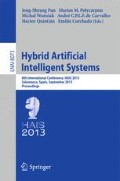Abstract
The goal of this paper is to show EMG based system control applied to motorized orthoses. Through two biometrical sensors it captures biceps and triceps EMG signals, which are then filtered and processed by an acquisition system. Finally an output/control signal is produced and sent to the actuators, which will then perform the proper movement. The research goal is to predict the movement of the lower arm through the analysis of EMG signals, so that the movement can be reproduced by an arm orthosis, powered by two linear actuators.
Access this chapter
Tax calculation will be finalised at checkout
Purchases are for personal use only
Preview
Unable to display preview. Download preview PDF.
References
Kawamoto, H., Sankai, Y.: Power assist system HAL-3 for gait disorder person. In: Miesenberger, K., Klaus, J., Zagler, W.L. (eds.) ICCHP 2002. LNCS, vol. 2398, pp. 196–203. Springer, Heidelberg (2002)
Kawamoto, H., Kanbe, S., Sankai, Y.: Power assist method for HAL-3 estimating operator’s intention based on motion information. In: IEEE Workshop on Robot and Human Interactive Communiaction (Millbrae), pp. 67–72 (2003)
Kawamoto, H., Suwoong, L., Kanbe, S., Sankai, Y.: Power assist method for HAL-3 using EMG-based feedback controller. In: IEEE International Conference on Systems, Man and Cybernetics, pp. 1648–1653 (2003)
Yamamoto, K., Hyodo, K., Ishii, M., Matsuo, T.: Development of power assisting suit for assisting nurse labor. JSME International Journal Series, 703–711 (2002)
Yamamoto, K., Hyodo, K., Ishii, M., Yoshimitsu, T., Matsuo, T.: Development of power assisting suit. JSME International Journal Series, 923–930 (2003)
Pratt, J.E., Krupp, B.T., Morse, C.J., Collins, S.H.: The RoboKnee: An exoskeleton for Enhancing Strength and Endurance During Walking. In: IEEE International Conference on Robotics and Automation (New Orleans), pp. 2430–2435 (2004)
Kong, K., Jeon, D.: Design and control of an exoskeleton for the elderly and patients. IEEE/ASME Transactions on Mechatronics, 220–226 (2006)
Agrawal, S.K., Fattah, A.: Theory and design of an orthotic device for full or partial gravity-balancing of a human leg during motion. IEEE Transactions on Neural Systems and Rehabilitation Engineering, 157–165 (2004)
Day, S.: Important factors in surface EMG measurement. Bortec (2009)
Reaz, M.B.I., Hussain, M.S., Mohd-Yasin, F.: Techniques of EMG analysis: detection, processing, classification and applications. Biological Procedures (2006)
Hug, F.: Can muscle coordination be precisely studied by surface electromyography? Journal of Electromyography and Kinesiology 21, 1–12 (2011)
Hermens, H.J., Freriks, B., Disselhorst-Klug, C., Rau, G.: Development of recommendations for SEMG sensor placement procedures. Journal of Electromyography and Kinesiology 10, 367–374 (2000)
Ng, A.Y.: Lecture on machine learning: principal component analysis and independent component analysis in relation to unsupervised machine learning, Stanford (2008)
Havran, C., Hupet, L., Czyz, J., Lee, J., Vandendorpe, L., Verleysem, M.: Independent component analysis for face authentication. In: Knowledge-based Intelligent Information Engineering Systems & Allied Technologies. IOS Press, Crema (2009)
Agrawal, A.: Independent component analysis vs factor analysis. ENEE698A Seminar (2003)
Ripley, B.: Principal component analysis and factor analysis. University of Oxford: Department of Statics (2009)
Hill, T., Lewicki, P.: Statistics: methods and applications. A comprehensive reference for science, industry and data mining. Statsoft (2006)
di Milano, P.: A tutorial on clustering algorithms. Home Polimi (2009)
Cohn, D.: Mixtures of Gaussians. School of Computer Science Carnegie Mellon University (1996)
Moore, A.W.: Clustering with Gaussian Mixtures. School of Computer Sciencie. Carnegie Mellon University (2004)
Orjuela, A., Calôba, L.: Clasificación de Movimientos en Extremidades Usando Redes Neuronales: I. Proceso Supervisado. In: 21º Congresso Brasileiro em Engenharia Biomédicas (2008)
Author information
Authors and Affiliations
Editor information
Editors and Affiliations
Rights and permissions
Copyright information
© 2013 Springer-Verlag Berlin Heidelberg
About this paper
Cite this paper
Suberbiola, A., Zulueta, E., Lopez-Guede, J.M., Etxeberria-Agiriano, I., Van Caesbroeck, B. (2013). Arm Orthosis/Prosthesis Control Based on Surface EMG Signal Extraction. In: Pan, JS., Polycarpou, M.M., Woźniak, M., de Carvalho, A.C.P.L.F., Quintián, H., Corchado, E. (eds) Hybrid Artificial Intelligent Systems. HAIS 2013. Lecture Notes in Computer Science(), vol 8073. Springer, Berlin, Heidelberg. https://doi.org/10.1007/978-3-642-40846-5_51
Download citation
DOI: https://doi.org/10.1007/978-3-642-40846-5_51
Publisher Name: Springer, Berlin, Heidelberg
Print ISBN: 978-3-642-40845-8
Online ISBN: 978-3-642-40846-5
eBook Packages: Computer ScienceComputer Science (R0)

